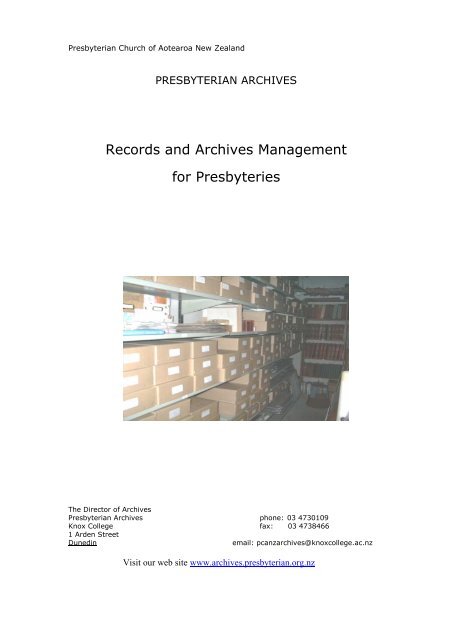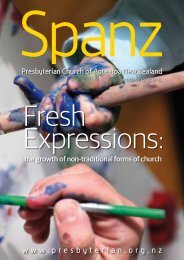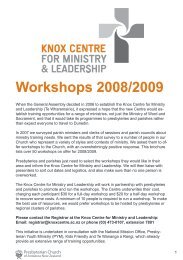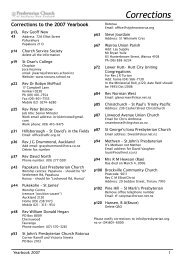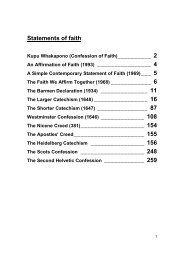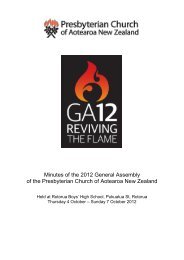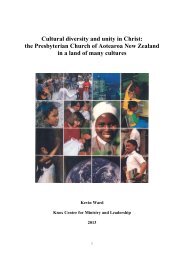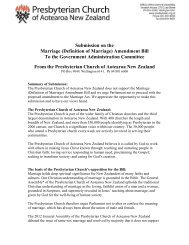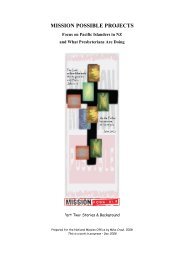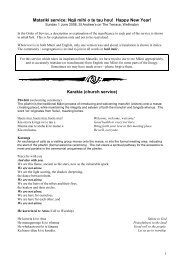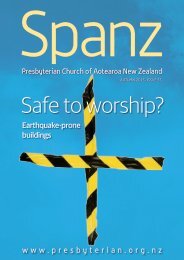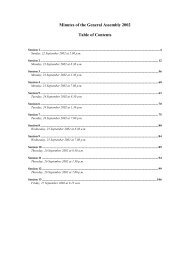Records and Archives Management for Presbyteries - Presbyterian ...
Records and Archives Management for Presbyteries - Presbyterian ...
Records and Archives Management for Presbyteries - Presbyterian ...
Create successful ePaper yourself
Turn your PDF publications into a flip-book with our unique Google optimized e-Paper software.
<strong>Presbyterian</strong> Church of Aotearoa New Zeal<strong>and</strong><br />
PRESBYTERIAN ARCHIVES<br />
<strong>Records</strong> <strong>and</strong> <strong>Archives</strong> <strong>Management</strong><br />
<strong>for</strong> <strong>Presbyteries</strong><br />
The Director of <strong>Archives</strong><br />
<strong>Presbyterian</strong> <strong>Archives</strong> phone: 03 4730109<br />
Knox College fax: 03 4738466<br />
1 Arden Street<br />
Dunedin<br />
email: pcanzarchives@knoxcollege.ac.nz<br />
Visit our web site www.archives.presbyterian.org.nz
DRAFT NO.3<br />
This document is still under construction. It <strong>for</strong>ms part of a larger document of <strong>Records</strong> <strong>and</strong> <strong>Archives</strong><br />
<strong>Management</strong>. The aim is <strong>for</strong> these documents to become part of a Parish <strong>and</strong> Presbytery H<strong>and</strong>book.<br />
Contents:<br />
1. What is <strong>Records</strong> <strong>Management</strong><br />
-Who is responsible?<br />
- What are the benefits?<br />
2. What is a record<br />
-Ownership of records<br />
-Significant <strong>and</strong> vital records<br />
3. Electronic <strong>Records</strong><br />
-What is Electronic <strong>Records</strong> <strong>Management</strong>?<br />
-What are electron/digital records<br />
-How does the preservation of digital records<br />
differ?<br />
-What are we to do?<br />
-What should we print?<br />
4. Privacy Act Issues<br />
-Recorded Personal In<strong>for</strong>mation <strong>and</strong> Privacy<br />
-Factors to guide collection of in<strong>for</strong>mation<br />
-The Privacy Act<br />
- Privacy Principles<br />
-Protection of Confidentiality<br />
-Some important considerations<br />
5. Organising <strong>Records</strong> <strong>and</strong> Files<br />
-Filing Systems<br />
-Intellectual Control of filing system<br />
-Organising files<br />
-Naming files<br />
-Labelling files<br />
-Attaching records to files<br />
-Some Tips <strong>for</strong> Improving files<br />
6. Access Policy<br />
Appendix: A: <strong>Records</strong> Retention & Disposal Schedules<br />
- Disposal Schedule <strong>for</strong> emails<br />
Compiled by Yvonne Wilkie who acknowledges the assistance of a number of Archival H<strong>and</strong>books in<br />
particular the Evangelical Lutheran Church of America
‘The continuing influx of paper is never ending’.<br />
We are faced<br />
daily with the problems of what to keep, how <strong>and</strong> where to store records, what to<br />
discard <strong>and</strong> when. This manual is designed to offer assistance to ministers,<br />
office-bearers <strong>and</strong> members throughout the <strong>Presbyterian</strong> Church who have<br />
records management problems <strong>and</strong> decisions to make.<br />
1.00 What is <strong>Records</strong> <strong>Management</strong>?<br />
The guiding principle of records management is to ensure that in<strong>for</strong>mation is<br />
available when <strong>and</strong> where it is needed, in an organised <strong>and</strong> efficient manner, <strong>and</strong><br />
in a suitably maintained environment.<br />
A church records management program strives to achieve economy <strong>and</strong> efficiency<br />
in the creation, use, maintenance, <strong>and</strong> disposal of church records. Its basic<br />
purpose is to help answer that nagging question of what do I keep, <strong>for</strong> how long<br />
do I keep it <strong>and</strong> when can I remove it from my office.<br />
A <strong>Records</strong> <strong>Management</strong> Programme identifies, maintains, safeguards, <strong>and</strong><br />
properly disposes of useful <strong>and</strong> vital records from all the committees <strong>and</strong> groups<br />
<strong>for</strong>med within our <strong>Presbyteries</strong> <strong>and</strong> parishes.<br />
Good records management is good stewardship <strong>and</strong> establishes a healthy<br />
ministry at parish <strong>and</strong> presbytery level.<br />
1.20 Who is responsible <strong>for</strong> ensuring good records management in the<br />
parish <strong>and</strong> presbytery?<br />
It is a responsibility shared by ministers, church workers, office bearers <strong>and</strong><br />
members.<br />
We all create <strong>and</strong> accumulate records in the roles we hold within our parish <strong>and</strong><br />
presbytery work. In our churches or presbyteries the records we create prove our<br />
groups existence <strong>and</strong> confirm the function <strong>and</strong> activity delegated to us. The<br />
papers that accumulate record the commitment, obligations, activities <strong>and</strong> legal<br />
requirements as a congregation, or associated organisation or presbytery, <strong>and</strong> as<br />
a member or employee.<br />
The PCANZ do not have specific regulations laid down in its Book of Order as to<br />
who is responsible <strong>for</strong> the oversight of records management at parish or
presbytery level. However, it is important to note that the Book of Order states<br />
in clauses 63, 113 <strong>and</strong> 140 that:<br />
The Clerk [of Session, Deacons’ Court or Board of Managers or Presbytery]<br />
keeps minutes of the proceedings <strong>and</strong> takes charge of books, papers <strong>and</strong><br />
documents pertaining to the office.<br />
It is there<strong>for</strong>e, important that some discussion take place among the officebearers<br />
to ensure a st<strong>and</strong>ardised records management procedure is followed<br />
within the parish courts or Parish Council <strong>and</strong> its committees. It is also helpful<br />
to <strong>for</strong>mulate an overall policy <strong>for</strong> the oversight of the entire parish records <strong>and</strong><br />
archives. (see below)<br />
1.30 What are the benefits of good records management?<br />
Protection of confidentiality<br />
A means of ensuring compliance with legal, fiscal <strong>and</strong> administrative<br />
requirements<br />
Protect the interests of employees<br />
Faster retrieval of in<strong>for</strong>mation <strong>for</strong> those people who work with the<br />
records<br />
Know what records they have, <strong>and</strong> locate them easily<br />
Increase efficiency <strong>and</strong> effectiveness<br />
Support decision making<br />
Provide continuity in the event of a disaster<br />
Fewer lost or misplaced records<br />
Control of the records <strong>for</strong> the period of its life<br />
Protection of the parish or presbytery’s important <strong>and</strong> historical records<br />
Good management can save space<br />
2.00 What is a Record?<br />
A record is any recorded in<strong>for</strong>mation produced or received in the initiation,<br />
conduct or completion of an institutional or individual activity <strong>and</strong> that<br />
comprises content, context <strong>and</strong> structure sufficient to provide evidence of<br />
the activity. (Ellis (ed), Keeping <strong>Archives</strong>, p. 477)<br />
Each Congregational Group <strong>and</strong> Presbytery creates <strong>and</strong> collects all kinds of<br />
records but there are records that are uni<strong>for</strong>m to most Groups.<br />
Minute Books, Agendas <strong>and</strong> meeting papers<br />
Reports - annual <strong>and</strong> committee<br />
Correspondence <strong>and</strong> Memos<br />
Financial records- cash books, ledgers, journals,<br />
Annual reports<br />
Newsletters- magazines, church bulletins, orders of worship<br />
(weekly <strong>and</strong> special)<br />
Rolls/Registers, - Marriage, Membership – communicant,<br />
adherents <strong>and</strong> pastoral, Baptism, Service, Cradle Roll, Sunday<br />
School, Youth Groups<br />
Personnel Files<br />
Legal documents<br />
Property – maps, plans, architectural drawings, building<br />
specifications, contracts
Jubilee <strong>and</strong> centennial celebration records: minutes,<br />
correspondence, registration <strong>for</strong>ms, photographs, ephemera,<br />
financial records, audio/video recordings,<br />
Databases <strong>and</strong> Reports<br />
Projects<br />
Published resources<br />
Photographic images<br />
Audio<br />
Scrapbooks, ephemera <strong>and</strong> artefacts<br />
These records may be created <strong>and</strong> conserved in a variety of <strong>for</strong>mats. The same<br />
in<strong>for</strong>mation maybe retained in several different <strong>for</strong>mats:<br />
Hard copy<br />
Electronic - word processing, database, web page<br />
Micrographs<br />
Computer floppies,<br />
CD's<br />
Photographic images<br />
Video <strong>and</strong> audio tapes<br />
NOTE:<br />
Ownership of records:<br />
In<strong>for</strong>mation that is created <strong>and</strong> retained in hard copy or electronic files produced<br />
by congregational courts <strong>and</strong> organisations <strong>and</strong> <strong>Presbyteries</strong> <strong>and</strong> its associated<br />
groups, or ministers <strong>and</strong> pastors employees/Conveners/Co-Directors in order to<br />
carry out their function as employees of the PCANZ is the property of the<br />
<strong>Presbyterian</strong> Church of Aotearoa New Zeal<strong>and</strong>. Such in<strong>for</strong>mation is not the<br />
property of any of the above groups or people to use, remove, retain personally,<br />
or destroy at will.<br />
Members of the congregational courts <strong>and</strong> organisations, Presbytery personnel<br />
<strong>and</strong> other appointed personnel are the custodians of the documents they retain.<br />
Preserving <strong>Presbyterian</strong> cultural heritage cannot be done without involving its<br />
custodians<br />
In 1985 the General Assembly ruled that:<br />
No church records held by any church body, parish, presbytery officer, or official<br />
be gifted, disposed of in any manner with the concurrence of the Historical<br />
<strong>Records</strong> Committee [Archivist]<br />
Significant <strong>and</strong> vital records:<br />
It is important to recognise what records are vital to the on-going life of the<br />
parish or presbytery. If a church building burns, destroying the entire record of a<br />
congregation, the congregation would undoubtedly find a way to continue.<br />
However, it would face overwhelming inconvenience <strong>and</strong> its underst<strong>and</strong>ing of its<br />
heritage would be weakened.<br />
Each congregation <strong>and</strong> presbytery should determine what records would be vital<br />
to its continued operation following an emergency. Remember that copies of
many types of records will exist elsewhere e.g. with Inl<strong>and</strong> Revenue, Insurance<br />
Company, Banks, PCANZ Office.<br />
Really vital parish records, such as baptismal registers, should be photocopied<br />
<strong>and</strong> stored in the PCANZ <strong>Archives</strong>.<br />
Rule of Thumb: Could you easily re-establish congregational life without the<br />
particular record?<br />
3.00 Electronic <strong>Records</strong>:<br />
Professional archivists have just begun to tackle the problem of preservation <strong>and</strong><br />
accessibility of electronic or machine readable records. Currently, common<br />
electronic record storage media, that is, computer tapes <strong>and</strong> disks, are<br />
susceptible to damage <strong>and</strong> cannot be considered permanent. New computer<br />
technologies may bring some answers to long-term archival needs. But new<br />
technologies may create another problem, which is accessibility of records with<br />
outdated or absent software or hardware. There<strong>for</strong>e, to maintain records in an<br />
electronic <strong>for</strong>m, a commitment must be made to update continually <strong>and</strong> convert<br />
all records to the newest <strong>for</strong>mats, disks or tapes<br />
3.10 What is Electronic <strong>Records</strong> <strong>Management</strong>?<br />
A lot of mystique has built up surrounding electronic records management <strong>and</strong><br />
what it involves. The management of documents we create electronically require<br />
the same sound records management principles applied to them as our paper<br />
records. The risks of not controlling electronic records are similar but different to<br />
those risks of not controlling our paper/hard copy records.<br />
Managing our electronic records on the computer is not a "quick fix". It cannot be<br />
seen as a technological solution to the reduction of records retention or the<br />
saving of space.<br />
3.20 What are electronic/digital records?<br />
<strong>Records</strong> created digitally in the day-to-day business of the organisation <strong>and</strong><br />
assigned <strong>for</strong>mal status by the organisation. They may include <strong>for</strong> example, word<br />
processing documents, emails, databases, or intranet web pages.<br />
3.30 How does the preservation of digital records differ?<br />
Retaining digital records over time is different to retaining paper copies <strong>for</strong> these<br />
reasons:<br />
• A dependency on specific hardware <strong>and</strong> software to access over long<br />
periods of time.<br />
• The speed of changes in technology means that the timeframe during<br />
which action must be taken is reduced from centuries with paper opposed<br />
to perhaps only 2-5 years with digital records.
• Obsolescence of technology is the greatest technical threat to ensuring<br />
continued access to digital material.<br />
• Fragility of the media. Floppy disks, CDs & DVDs <strong>and</strong> tape digital materials<br />
are stored on inherently unstable materials <strong>and</strong> can deteriorate very<br />
quickly.<br />
• The ability to change digital material from one software programme to<br />
another means that continued integrity, authenticity, <strong>and</strong> history of the<br />
digital materials is vulnerable.<br />
• A digital resource which is not selected <strong>for</strong> active preservation treatment<br />
at an early stage will very likely be lost or unusable in the near future.<br />
(from: The Preservation <strong>Management</strong> of Digital Material H<strong>and</strong>book)<br />
3.40 Can we retain our electronic documentation in that <strong>for</strong>mat?<br />
The simple answer is NO. Floppy disks, CD’s <strong>and</strong> DVD’s continue to be a<br />
vulnerable medium to retain our in<strong>for</strong>mation. There is a very real threat that the<br />
digital materials will be created in such a way that not even their short-term<br />
viability can be assured, much less the prospect that future generations will also<br />
have access to them.<br />
3.50 What are we to do?<br />
The short-term answer to storage of electronic records is to store paper copies as<br />
back up <strong>for</strong> all correspondence, reports, <strong>and</strong> minutes. Parish membership lists<br />
<strong>and</strong> other data that are updated often should be printed <strong>and</strong> dated regularly. For<br />
both long- <strong>and</strong> short-term storage, back-up copies should be made regularly <strong>and</strong><br />
stored separately, in a separate building, if at all possible. Data loss can occur <strong>for</strong><br />
a variety of reasons during active use or in storage. Adequate back up will ensure<br />
that a high percentage of data can be restored <strong>for</strong> current activities.<br />
All significant documentation should be printed out in hard copy <strong>for</strong>mat<br />
3.60 What should we print out?<br />
The Retention <strong>and</strong> Disposal Schedule below is a good guideline. The material that<br />
is recommended <strong>for</strong> permanent <strong>Archives</strong> preservation will be the material that<br />
should not remain in digital <strong>for</strong>mat.<br />
• If the records use is primarily <strong>for</strong> reading/reference <strong>and</strong> its value is<br />
permanent, print <strong>and</strong> preserve a paper copy as the original.<br />
• If the record is required to follow-up our legal <strong>and</strong> evidential activities, in<br />
other words a paper trail retain a paper copy as the original<br />
• If the record is primarily <strong>for</strong> reading/reference <strong>and</strong> its value is temporary,<br />
preserve in whatever <strong>for</strong>m is most convenient <strong>for</strong> use at the active <strong>and</strong><br />
inactive stages of its life.<br />
• If the record is primarily <strong>for</strong> data control <strong>and</strong> manipulation (e.g.<br />
accounting files, membership databases), preserve st<strong>and</strong>ard reports<br />
(such as annual financial reports) in paper <strong>for</strong>m. Preserve the computer
ecords in electronic <strong>for</strong>m. However, these records must be maintained<br />
on media (e.g. disks) compatible with current hardware <strong>and</strong> kept<br />
compatible with upgrades or changes in software.
New Zeal<strong>and</strong> Privacy Act Issues<br />
4.00 Recorded Personal In<strong>for</strong>mation <strong>and</strong> Privacy (<strong>for</strong> detailed in<strong>for</strong>mation<br />
relating to Privacy Regulations see the Privacy Commissioners web-site<br />
http://www.privacy.org.nz/ )<br />
If we want to keep in touch with the members within our parish or presbytery we<br />
do this by creating membership rolls <strong>and</strong> phone lists . Administration of a parish<br />
community also obliges the officers within our groups to collect data on<br />
individuals. Some of this data is required by our church regulations <strong>and</strong> other<br />
data by civil law.<br />
This in<strong>for</strong>mation <strong>and</strong> data may cover:<br />
Directory & newsletter delivery lists*<br />
Membership rolls <strong>and</strong> transfer records<br />
Baptism records<br />
Marriage licences & registers, dissolution certificates (see below Public<br />
Register Privacy)<br />
pledge lists,<br />
records of donations,<br />
pastoral visitation notes,<br />
employee records,<br />
superannuation in<strong>for</strong>mation, <strong>and</strong><br />
tax related records.<br />
* Directory in<strong>for</strong>mation such as a name, address <strong>and</strong> telephone number does not<br />
normally qualify as sensitive data. Such data could be perceived as personal<br />
in<strong>for</strong>mation if someone decided to distribute the data to a third party in the <strong>for</strong>m<br />
of a mailing list or <strong>for</strong> pecuniary gain.<br />
Twelve years on the Privacy Act is not generating the over reaction it initially did.<br />
However, as we collect <strong>and</strong> store in<strong>for</strong>mation about our ministers <strong>and</strong><br />
parishioners we need to be diligent at all times to our ethical responsibilities to<br />
protect the privacy of the shared in<strong>for</strong>mation we gather. The loss of trust <strong>and</strong> the<br />
ill feelings generated by an insensitive presumption of unchecked control over<br />
in<strong>for</strong>mation can be damaging to the health of the congregation.<br />
4.10 Two factors that should guide the collection, use, or distribution of<br />
personal in<strong>for</strong>mation are:<br />
the relative sensitivity of the in<strong>for</strong>mation <strong>and</strong><br />
the individual's expectation about how the parish will use it.<br />
Several questions can be asked to determine the confidentiality of personal data.<br />
The first question to ask is:<br />
what would the individual's reasonable expectation be regarding the way<br />
in which the in<strong>for</strong>mation will be used?
consider whether the in<strong>for</strong>mation has changed h<strong>and</strong>s:<br />
did the individual assume the in<strong>for</strong>mation would be shared beyond the<br />
recipient?<br />
the nature <strong>and</strong> purpose <strong>for</strong> which the in<strong>for</strong>mation was originally conveyed<br />
should be the controlling factor:<br />
is the in<strong>for</strong>mation being used or circulated in a way that ignores the<br />
sensitivities or intentions of the individual?<br />
4.20 The Privacy Act (1993) is ‘directly concerned with in<strong>for</strong>mation privacy<br />
about identifiable individuals’ <strong>and</strong> applies in particular to the public<br />
disclosure of in<strong>for</strong>mation collected by any organisation or individual. The<br />
Act imposes regulations on all who gather <strong>and</strong> hold personal in<strong>for</strong>mation.<br />
In particular the Act bears directly on the use, distribution <strong>and</strong> storage of<br />
in<strong>for</strong>mation by those who gather it. The parish <strong>and</strong> Presbytery must<br />
recognize both the legal implications <strong>and</strong> the ethics of maintaining secure<br />
access to records that could potentially cause harm or personal<br />
embarrassment if carelessly disclosed.<br />
4.30 Privacy Act Principles<br />
There are twelve privacy principles which impose requirements on the gathering<br />
of in<strong>for</strong>mation covering:<br />
How, why <strong>and</strong> from whom personal in<strong>for</strong>mation can be collected<br />
Rights of access to <strong>and</strong> correction of personal in<strong>for</strong>mation<br />
Accuracy, completeness <strong>and</strong> relevance of personal in<strong>for</strong>mation<br />
Disclosure of personal in<strong>for</strong>mation<br />
Safe storage of in<strong>for</strong>mation<br />
‘The principles also give individuals the right to access personal in<strong>for</strong>mation <strong>and</strong><br />
to request correction of it. They do not override other laws which govern the<br />
collection, use or disclosure of personal in<strong>for</strong>mation’.<br />
4.31 * ‘The Act also contains four public register privacy principles which limit:<br />
• the manner in which in<strong>for</strong>mation can be made available from public<br />
registers;<br />
• re-sorting or combining public register in<strong>for</strong>mation <strong>for</strong> commercial gain;<br />
• electronic transmission of public registers;<br />
• charging <strong>for</strong> access to public register in<strong>for</strong>mation.<br />
The Act sets out a complaints mechanism <strong>and</strong> contains rules regulating<br />
in<strong>for</strong>mation matching.’<br />
4.40 Protection of Confidentiality<br />
A guiding principle of a records management policy is to note:
that the records created by an organisation within the structures of the<br />
congregation are the property of the parish corporate.<br />
Consideration needs to be given by parish <strong>and</strong> presbytery office-bearers to the<br />
access, retention <strong>and</strong> disposition of the records while housed at Parish <strong>and</strong><br />
Presbytery level. Access may be delegated to a specific person such as the Clerk<br />
of Presbytery or a parish archivist, but clear underst<strong>and</strong>ings should be put in<br />
place, in job descriptions or policy statements, covering the conditions <strong>and</strong><br />
authority <strong>for</strong> releasing in<strong>for</strong>mation. Even the most general guidelines will indicate<br />
the congregation or presbytery’s intent <strong>and</strong> cause an individual to pause when<br />
considering access or destruction of a record.<br />
The parish or presbytery requires a records management programme that will aid<br />
it from exposure to public embarrassment <strong>and</strong> liability.<br />
4.41 Some important considerations are:<br />
establish a management approach to the creation, use, <strong>and</strong><br />
maintenance of computer records;<br />
examine the relevance <strong>and</strong> need <strong>for</strong> the specific fields of data being<br />
collected;<br />
establish <strong>and</strong> follow a regular schedule of records retention <strong>and</strong><br />
disposition;<br />
locate <strong>and</strong> make secure the more sensitive in<strong>for</strong>mation sources at the<br />
principle place of congregational business (not in private homes);<br />
obtain the consent of individuals to release in<strong>for</strong>mation of a personal<br />
nature when the data is being used <strong>for</strong> any other purpose than the<br />
original intent; <strong>and</strong><br />
maintain accurate records.<br />
Keep in mind that employees have a right to examine records maintained on<br />
them; it may be assumed that members of the congregation have much the same<br />
privilege.
5.00 Organisation of <strong>Records</strong> <strong>and</strong> Files (see <strong>for</strong> further assistance, Parish H<strong>and</strong>book<br />
a quick reference guide to <strong>Presbyterian</strong> Church regulations <strong>and</strong> procedures, published by the Synod of<br />
Otago <strong>and</strong> Southl<strong>and</strong> 2002)<br />
"Thorough <strong>and</strong> well-kept church records are hard work, but they also can help<br />
bring order to the world of Christian ministry <strong>and</strong> serve as a valuable tool <strong>for</strong> the<br />
leader's task."<br />
“Record keeping <strong>for</strong>ms the knowledge base <strong>for</strong> in<strong>for</strong>med planning.” (John W.<br />
Ellas, Church Growth 12 :3. 1997)<br />
Parish courts <strong>and</strong> organisations, <strong>and</strong> <strong>Presbyteries</strong> must ensure that their records<br />
are:<br />
Authentic<br />
It must be possible to prove that records are what they purport to be <strong>and</strong> have<br />
evidence as to who created them, by keeping a record of their management<br />
through time.<br />
Accurate<br />
<strong>Records</strong> must accurately reflect the transactions that they document.<br />
Accessible<br />
<strong>Records</strong> must be readily available when needed.<br />
Complete<br />
<strong>Records</strong> must be sufficient in content, context <strong>and</strong> structure to reconstruct the<br />
relevant activities <strong>and</strong> transactions that they document.<br />
Comprehensive<br />
<strong>Records</strong> must document the complete range of the business of the various courts<br />
<strong>and</strong> organisations of the parish.<br />
Compliant<br />
<strong>Records</strong> must comply with any record keeping requirements resulting from<br />
legislation, audit rules <strong>and</strong> other relevant regulations such as those found <strong>for</strong><br />
financial record keeping, <strong>and</strong> in<strong>for</strong>mation that may fall under the Privacy Act.<br />
Effective<br />
<strong>Records</strong> must be maintained <strong>for</strong> specific purposes <strong>and</strong> the in<strong>for</strong>mation contained<br />
in them must meet those purposes.<br />
Secure<br />
<strong>Records</strong> must be securely maintained to prevent unauthorised access, alteration,<br />
damage or removal. They must be stored in a secure environment, the degree of<br />
security reflecting the sensitivity <strong>and</strong> importance of the contents. If electronic<br />
records are migrated across changes in technology, it is imperative that the<br />
documents retain accuracy <strong>and</strong> authenticity. (National <strong>Archives</strong> of Scotl<strong>and</strong>)
5.1 Filing Systems:<br />
Each Moderator, Clerk, Committee Convener will have created a filing<br />
system over time. Each new encumbant will have amended this previous<br />
system or changed it completely. We have no official guidelines how or<br />
why a file should be kept <strong>and</strong> what requires to be retained in it. As a<br />
consequence everything to do with whatever is being created is placed in a<br />
file <strong>and</strong> labelled with a title that may or may not purport to be what it<br />
contains. This can often cause confusion <strong>for</strong> those attempting to retrieve<br />
in<strong>for</strong>mation. For ease of access <strong>and</strong> retrieval it is important that<br />
consistency exists <strong>and</strong> a st<strong>and</strong>ardised <strong>and</strong> uni<strong>for</strong>m approach is developed<br />
within each set of group/committee records.<br />
What are Files:<br />
(1) An organised unit of documents, accumulated during current use <strong>and</strong><br />
kept together because they deal with the same subject, activity or<br />
transaction <strong>and</strong> which may or may not be fastened together with or<br />
without a cover. Ellis (ed), Keeping <strong>Archives</strong>, p. 462<br />
(2) A complete, named collection of in<strong>for</strong>mation, such as a program, a set<br />
of data used by a program, or user-created document. A file is the basic<br />
unit of storage that enables a computer to distinguish one set of<br />
in<strong>for</strong>mation from another. A file might or might not be stored in humanreadable<br />
<strong>for</strong>m, but it is still the "glue" that binds a conglomeration of<br />
instructions, numbers, words, or images into a coherent unit that a user<br />
can retrieve, change, delete, save or send to an output devise. Ellis (ed),<br />
Keeping <strong>Archives</strong>, p.470<br />
(3) A file contains a collection of documents which show a committee or<br />
Presbytery’s activities through an identifiable sequence of activities. This<br />
evidence <strong>for</strong>ms an important part of a good record keeping system <strong>and</strong><br />
promotes <strong>and</strong> supports an organisation's accountability <strong>and</strong> efficiency.<br />
NSW State <strong>Records</strong> Office<br />
5.2 Intellectual Control of a filing system<br />
It is important to think about how we create files because of the<br />
significance of the material held in the file <strong>and</strong> because we require to<br />
access it at a later time. There<strong>for</strong>e thought needs to be given to how we<br />
arrange <strong>and</strong> label the files <strong>and</strong> the placement of them in our day to day<br />
filing cabinets.<br />
1) Choices to be made include:<br />
• whether file categories should be used<br />
• what type of numbering system will be most effective<br />
• how will registration of records be h<strong>and</strong>led, with a manual system<br />
or records management software<br />
• what type of classification system will be most effective<br />
• how will documents be attached to files, <strong>and</strong>
• whether file numbering is required.<br />
2) Placing files in categories can bring a number of benefits:<br />
• files are organised into logical groups which relate to the functions <strong>and</strong><br />
activities of the work each designated group is undertaking<br />
• policy files are identified<br />
• disposal of files is more easily managed.<br />
3) However categorising files can also have a number of<br />
disadvantages:<br />
• it can add an unnecessary level of complication to the file numbering<br />
system if numbering is to be used<br />
• it can add an unnecessary <strong>and</strong> confusing level of control where a<br />
keyword system is used<br />
• where file categories are based on organisational structure,<br />
reorganisations will make file categories out of date <strong>and</strong> their value will<br />
be lost<br />
• where file categories are based on functions the categories will be<br />
similarly affected by changes in the organisation's functions or the<br />
terminology used to describe them.<br />
It is important that what we decide is simple, yet clearly defines the<br />
policy, administrative, <strong>and</strong> functional activities of the work we do.<br />
1) Policy<br />
This category contains those files which document the organisation's policy<br />
on any matter. These files document the development of policy in any of<br />
the organisation's jurisdictions or functions.<br />
2) Administrative<br />
This category contains the files which relate to the day-to-day<br />
administrative activities of the organisation. It includes routine,<br />
housekeeping matters such as meeting times <strong>and</strong> appointments,<br />
establishment files.<br />
3) Functions<br />
This category contains the files which relate to the specific functions which<br />
the designated groups were established to per<strong>for</strong>m. These functions may<br />
be defined by regulations, articles of incorporation, organisational<br />
structure, or business plans. Functions delineate <strong>and</strong> describe the activities<br />
which produce records. The choice of functional categories should be<br />
made on the basis of what best serves the needs of the designated group.<br />
These categories should reflect the way in which the each group operates.
5.3 Organising Files<br />
The organization of records <strong>and</strong> files should be kept simple <strong>and</strong> direct. Use the<br />
rule of thumb that the arrangement should be quickly understood by another<br />
person who could take over the position of Clerk/Secretary/Moderator.<br />
It is important to think about how to create files to highlight the significance of<br />
the material contained in them. There<strong>for</strong>e thought needs to be given to how we<br />
arrange <strong>and</strong> label the files <strong>and</strong> the placement of them in filing cabinets <strong>for</strong> ready<br />
access in day to day use.<br />
What is decided needs to be simple, yet will clearly define the policy,<br />
administrative, <strong>and</strong> functional activities of the work each person or group<br />
undertakes. The functions <strong>and</strong> responsibilities of a designated office can be<br />
classified into subjects or arranged into identifiable groups of records e.g.<br />
Financial/Accounting <strong>Records</strong>:<br />
Payables <strong>and</strong> Receivables<br />
Account Balancing<br />
Funds <strong>and</strong> Investments <strong>Management</strong><br />
Books of Permanent Entry<br />
Budgetary Planning<br />
Financial Reporting<br />
Payroll <strong>and</strong> Benefits/Tax<br />
Stewardship/Fund Raising<br />
Contracts <strong>and</strong> Agreements<br />
Bequests <strong>and</strong> Trusts<br />
5.4 Naming Files:<br />
Properly naming a file is an elementary rule. Documents, reports, minutes,<br />
account books <strong>and</strong> folders should have labels with titles <strong>and</strong> dates. St<strong>and</strong>ardize<br />
the way that headings are assigned to folders, using common (i.e. memorable)<br />
keywords that will come to mind a year or more later.<br />
5.5 Labelling assists in:<br />
• faster identification <strong>and</strong> retrieval of records<br />
• fuller intellectual control of created records<br />
• assists new employees<br />
• reduces risk of misfiling<br />
• it assists in the identification of vital files<br />
`<br />
A label requires having on it:<br />
Name of Parish<br />
Name of Parish Court or Organisation<br />
File title<br />
Consecutive number if applicable<br />
Disposal details<br />
related file if applicable<br />
any instructions to file users<br />
any restricted access notes. (See Access Policies)
The labelling <strong>for</strong>mat can either be copied <strong>and</strong> each file has it glued onto<br />
the outside or it or better still commercial printing of the label to<br />
st<strong>and</strong>ardise them across the General Assembly administrative groups.<br />
The label could have a series record number printed <strong>and</strong> then sub category<br />
numbers left to be added.<br />
Example of a label:<br />
<strong>Presbyterian</strong> Church of Aotearoa NZ<br />
Parish: St. George’s, Georgetown<br />
Group: Session<br />
Creator: Session Clerk<br />
Subject File:<br />
Elders’ Retreat<br />
Disposal Details: retain <strong>for</strong> 5 years – then Archive<br />
Instructions: File is organised by date from the earliest to the latest<br />
RESTRICTED ACCESS:<br />
Nil<br />
Date of Release:<br />
Written Permission <strong>for</strong> Access from:<br />
5.6 Attaching records to a file<br />
The Archivist strongly recommends the use of plastic paper clips where<br />
documents are to be kept together. Staples, pins, <strong>and</strong> metal fasteners rust.<br />
5.7 Some Tips <strong>for</strong> Improved Filing<br />
• File regularly. Set aside time weekly or monthly to keep the "paper<br />
monster" in control.<br />
• Weed out duplicate copies<br />
• Do not fill folders beyond their capacity, normally one-half to three-fourths<br />
of an inch<br />
• If the materials from a committee or organization occupy more than one<br />
folder, divide the files into other categories <strong>for</strong> arrangement. For<br />
example, the first folder may contain minutes, the second<br />
correspondence, the third reports <strong>and</strong> so on. Start a new folder <strong>for</strong> each<br />
category as needed <strong>and</strong> label as Part #1, Part #2 etc.<br />
• Keep personal material <strong>and</strong> resource material (e.g. catalogues, copies of<br />
articles, pamphlets etc.) separate from official records<br />
• When placing records in files, put the latest record on top. Place the top of<br />
the sheet toward the left of the file drawer, so folder contents can be
ead like a book. Keep records completely within folders to avoid<br />
damage <strong>and</strong> to keep file folder labels visible.<br />
• Close files <strong>and</strong> begin new ones at the beginning of each fiscal year or<br />
program year.<br />
• Copy documents that are on fax paper or newsprint onto high quality<br />
paper as these papers deteriorate.<br />
• The overall appearance of a file system plays a large part in the rapid<br />
retrieval of material. Guides <strong>and</strong> labels should be positioned consistently.<br />
Care should be taken to use the same <strong>for</strong>mat when generating new<br />
labels <strong>and</strong> guides.<br />
Since members are the lifeblood of congregational life, important records are<br />
often kept away from the Church. Our office-bearers need to be encouraged to<br />
retain as few records as possible in their private homes. It is especially important<br />
that all records be h<strong>and</strong>ed over to the new office-bearers when they have<br />
completed their term in office.<br />
6.00 Access Policy:<br />
Refer to the Privacy Act section <strong>and</strong> note again the importance of gathering<br />
personal in<strong>for</strong>mation.<br />
Any records pertaining to employment, disciplining of an office-bearer, sexual<br />
abuse complaints <strong>and</strong> other sensitive issues involving records that can identify<br />
people MUST be restricted. Files require being clearly labelled accordingly <strong>and</strong><br />
only designated people able to access them.<br />
These files once closed require being stored safely, noting the Privacy Act<br />
requirement. It is strongly recommended that any restricted file once closed be<br />
<strong>for</strong>warded to the <strong>Presbyterian</strong> <strong>Archives</strong>. There the records are stored in a<br />
controlled environment <strong>and</strong> can called up if <strong>and</strong> when required.<br />
Policy<br />
The <strong>Archives</strong> has followed an Access Policy from the outset. Until now the<br />
Archivist has been responsible <strong>for</strong> placing any restricted access to a record. The<br />
suggestion is that those creating records can now follow the system <strong>and</strong> place a<br />
restriction on any material they consider requires some protection. However, if<br />
the Archivist considers the restriction is unrealistic the restriction will be<br />
reassessed.<br />
Personnel files <strong>and</strong> Human Resources: 75 years from the closure<br />
of the file or 10 years from the death of the person at the Archivist's<br />
discretion.<br />
Disciplinary Commissions: 75 years from the closure of the file or<br />
10 years from the death of the person at the Archivist's discretion.<br />
G.A. Judicial Commissions: 35 years from the closure of the file<br />
AES <strong>Records</strong>: Included amongst these <strong>Records</strong> will be records<br />
containing personal in<strong>for</strong>mation, complaints <strong>and</strong> matters that may<br />
come under the Privacy Act, 1993. This material requires to be kept<br />
separate from general correspondence <strong>and</strong> labelled accordingly.
It is important to label any files with restricted records to avoid any<br />
person accessing them.<br />
RESTRICTED ACCESS:<br />
Date of Release:<br />
Written Permission <strong>for</strong> Access from:<br />
Any restricted record may be accessed prior to dates suggested with the<br />
written consent of the Presbytery Clerk or AES.<br />
Staff outside the creating body wishing to access these files also requires written<br />
consent of the Presbytery Clerk or AES. While these records are held by the<br />
Presbytery the consent notice will be filed with the record. Once in the <strong>Archives</strong><br />
this consent is filed in the <strong>Archives</strong> filing system.
APPENDIX A: <strong>Records</strong> Retention <strong>and</strong> Disposal Schedule<br />
This Schedule is a guideline <strong>for</strong>:<br />
Presbytery Clerks<br />
Convener’s of Committees<br />
Disposal scheduling is one of the main tools of records management. It<br />
documents what will happen to the records you accumulate in the long term. The<br />
schedule identifies which records should be:<br />
• permanently preserved,<br />
• those that can be destroyed at a specified time, <strong>and</strong><br />
• those which should be subject to a review at a future<br />
date, when a decision can be more easily reached.<br />
Decisions are normally made about groups, or series of records (linked by<br />
subject, or the function of the papers), rather than each individual file or<br />
document. (see Schedules below)<br />
The Schedule is broken down into the following series <strong>and</strong> applies to each group<br />
within the parish adapting it where necessary: Session, Board of Managers or<br />
Parish Council <strong>and</strong> its Committees; Youth Groups, Women’s Organisations, clubs,<br />
etc. The series are given a number <strong>for</strong> ease of filing.<br />
Series<br />
Description<br />
1.00 Minutes of Presbytery <strong>and</strong> Presbytery Committees<br />
2.00<br />
Correspondence<br />
3.00 Financial <strong>Records</strong><br />
4.00 Personnel records <strong>for</strong> persons employed by Presbytery<br />
5.00 Events, Conferences, training programmes <strong>and</strong> General<br />
Assemblies<br />
6.00 Published Resource Material required <strong>for</strong> Presbytery<br />
7.00 Relationship with Synods in Region, Ecumenical partners <strong>and</strong><br />
organisation<br />
8.00 Policy <strong>and</strong> Procedural Documents<br />
9.00 Supporting Documents of Official Statements<br />
10.00 Legal Inquiries<br />
11.00 Marriage Registers<br />
12.00 Historical Papers <strong>and</strong> Activities<br />
13.00 Property Documents - Plans
Presbytery Retention <strong>and</strong> Disposal Schedule:<br />
Series 1.00<br />
Minutes of Presbytery <strong>and</strong> Presbytery Committees<br />
Contents Instructions Final Disposition<br />
Formal minutes, including<br />
the Agenda, meeting<br />
papers, reports, <strong>and</strong> other<br />
meeting paper requirements<br />
The copy of meeting papers<br />
<strong>and</strong> minutes circulated to<br />
the Presbytery members<br />
should also be <strong>for</strong>warded to<br />
the <strong>Archives</strong> <strong>and</strong> AES.<br />
Permanent: To <strong>Archives</strong><br />
Retain completed Minute<br />
Book <strong>for</strong><br />
Any confidential material<br />
should be noted as such <strong>and</strong><br />
limited circulation made.<br />
10 years after last entry<br />
<strong>for</strong>ward to <strong>Archives</strong>.<br />
Minutes from Other<br />
<strong>Presbyteries</strong><br />
Retain <strong>for</strong> interest<br />
Destroy 2yrs after date<br />
Series 2.00<br />
Correspondence:<br />
For ease of Retrieval<br />
Use a filing system that is uni<strong>for</strong>m .<br />
For retrieval in the future it is better not to file letters in Alphabetical order<br />
File by date or subject<br />
File inward letters <strong>and</strong> responses together<br />
File only one copy of <strong>for</strong>m letters to a large mailing list <strong>and</strong> list who recipients<br />
are<br />
Do not retain routine memos permanently, unless you are the creator then<br />
retain one copy<br />
Do not retain permanently '<strong>for</strong> your in<strong>for</strong>mation' copies others have generated<br />
Observe these same rules <strong>for</strong> significant emails<br />
Where possible use a plastic paperclip to keep pages together. The Archivist<br />
has to removal staples <strong>and</strong> metal paper clips be<strong>for</strong>e preserving<br />
Do not use pins to hold papers together<br />
Contents Instructions Final Disposition<br />
General<br />
Received letters of thanks,<br />
condolence, Christmas<br />
cards, appointments <strong>and</strong><br />
meeting confirmation, travel<br />
arrangements, routine<br />
letters, office memos,<br />
Retain these in a filing<br />
system.<br />
Retain one copy of memo,<br />
routine letter, if creator of<br />
these. E.g. memo to<br />
Presbyters re special<br />
meeting arrangements<br />
Destroy after 2 years<br />
Alphabetical<br />
If alphabetical files <strong>and</strong><br />
subject files are retained<br />
simultaneously - i.e. a copy<br />
of correspondence is<br />
retained in both an<br />
alphabetical folder <strong>and</strong> a<br />
subject folder destroy the<br />
alphabetical file<br />
Destroy every 2 years
Subject Files<br />
Each new subject will be<br />
given a new series number,<br />
following on from the last<br />
designated number.<br />
Subject Files may include:<br />
Policy Group; policy<br />
statements with<br />
correspondence;<br />
Individual issues;<br />
<strong>Presbyteries</strong> <strong>and</strong><br />
parishes;<br />
Legal <strong>and</strong> policy matters<br />
Relating to any legal <strong>and</strong><br />
policy issues<br />
Selective retention -<br />
remove routine letters <strong>and</strong><br />
retain substantive letters.<br />
Ensure any personal <strong>and</strong><br />
sensitive record is noted as<br />
restricted <strong>and</strong> place in a<br />
separate file. Retain with<br />
the subject file <strong>and</strong> flag.<br />
Hold in Office <strong>for</strong> 5 yrs after<br />
subject closed.<br />
These files can be<br />
consecutively numbered<br />
beginning 2.41; 2.42; 2.43<br />
etc<br />
Note restricted access<br />
<strong>and</strong> separate off into<br />
separate files. Flag<br />
original files<br />
It is important to retain all<br />
correspondence as paper<br />
trails are vital<br />
Note restricted access<br />
<strong>and</strong> separate off into<br />
separate files. Flag<br />
original file <strong>and</strong> indicate<br />
material removed<br />
Permanent:<br />
ARCHIVE - 5 years after<br />
file is closed<br />
Permanent:<br />
ARCHIVE - Every five<br />
years<br />
Permanent:<br />
ARCHIVE - 5 years after<br />
file closed<br />
Series 3.00 Financial <strong>Records</strong>:<br />
Contents Instructions Final Disposition<br />
Routine financial records After the end of year reports Destroy after 3 years<br />
• Project financial reports are reconciled, the primary<br />
• Expense reports<br />
value <strong>for</strong> these records is<br />
• Copy invoices<br />
the development of the next<br />
• Payment requests year's budget<br />
• Budget development<br />
files<br />
Budget Preparation<br />
• All papers relating to<br />
budget preparation<br />
• approved budget<br />
• Long /short term<br />
schedules <strong>and</strong> strategies<br />
• Correspondence <strong>and</strong><br />
emails<br />
Application <strong>for</strong> funds<br />
• Copies of Grant <strong>for</strong>ms<br />
• Correspondence<br />
• Interpretative material<br />
After the Budget is approved<br />
the primary value <strong>for</strong> these<br />
records is the development<br />
of the next year's budget<br />
Retain Final Budget <strong>and</strong><br />
short <strong>and</strong> long term<br />
schedules <strong>and</strong> strategies<br />
<strong>and</strong> correspondence <strong>and</strong><br />
emails<br />
These papers may be used<br />
<strong>for</strong> future applications after<br />
the initial approach.<br />
Destroy all rough papers<br />
after 3 years<br />
Permanent:<br />
Archive after 5 years<br />
Destroy after 6 years
Series 4.00: Personnel records <strong>for</strong> persons employed by Presbytery<br />
Contents Instructions Final Disposition<br />
Individual Employees If the persons are employed<br />
•<br />
•<br />
•<br />
Applications<br />
C.V's<br />
Per<strong>for</strong>mance reviews<br />
or endorsed by the<br />
Presbytery, these records<br />
will be governed by policy<br />
set by the Human Resources<br />
Policy.<br />
Retained on site until<br />
employee leaves.<br />
Archive 1 year after the<br />
employee has terminated<br />
the employ.<br />
Restricted Access <strong>for</strong> 75<br />
years after closure of file or<br />
10 years after death at<br />
Archivist's discretion.<br />
Unsuccessful<br />
Applicants<br />
Per<strong>for</strong>mance Reviews<br />
Follow HR Policy laid down<br />
Return C.V's to applicants<br />
Retain any notes <strong>for</strong> 1 year<br />
Destroy 1 year after<br />
termination.<br />
Destroy 1 year<br />
Series 5.00<br />
Events, Conferences, training programmes <strong>and</strong> General Assemblies<br />
Contents Instructions Final Disposition<br />
(files divided up as best<br />
serves the event.)<br />
Permanent:<br />
• M<strong>and</strong>ate <strong>for</strong> the event<br />
ARCHIVE<br />
• Planning material<br />
Send to <strong>Archives</strong> within one<br />
Correspondence including<br />
year following the event.<br />
email<br />
• contracts<br />
• Minutes of planning<br />
meetings<br />
• Any grant applications<br />
• Promotional <strong>and</strong> project<br />
material<br />
• Registrations<br />
• Reports <strong>and</strong> Minutes of<br />
final meetings<br />
• Resources produced<br />
(print, electronic, audio,<br />
video)<br />
• Videos <strong>and</strong> photographs<br />
• Sermons<br />
• Speeches<br />
• Web-site presentation<br />
• Evaluations<br />
• Invoice copies <strong>and</strong><br />
Payment approvals<br />
Destroy after 2 years<br />
Series 6.00<br />
Published Resource Material required <strong>for</strong> Presbytery<br />
Contents Instructions Final Disposition<br />
• Newsletters<br />
Dated material of temporary<br />
• Journals<br />
nature<br />
• Reports<br />
• Conference publications<br />
• Pamphlets<br />
Material that has been<br />
significant in project <strong>and</strong><br />
decision making retain<br />
Annually clear files, <strong>and</strong><br />
send to <strong>Archives</strong> things 4<br />
years old.
Series 7.00 Relationship with Synods in Region, Ecumenical partners <strong>and</strong><br />
organisation<br />
Contents Instructions Final Disposition<br />
• Governing documents Applies to all Designated Permanent:<br />
• Correspondence<br />
(including emails)<br />
Groups involved in<br />
ecumenical conversations ARCHIVE every 5 years<br />
• Dialogues <strong>and</strong><br />
consultations<br />
<strong>and</strong> activities<br />
• Travel itineraries <strong>and</strong><br />
briefings<br />
• Minutes<br />
• Interpretive material<br />
• Histories<br />
• Worship services<br />
Series 8.00 Policy <strong>and</strong> Procedural Documents<br />
ARCHIVE - send as<br />
produced<br />
Contents Instructions Final Disposition<br />
Paper <strong>and</strong> web copies Retain until superseded Send to <strong>Archives</strong> as<br />
issued<br />
Series 9.00 Supporting Documents of Official Statements<br />
Contents Instructions Final Disposition<br />
• Original m<strong>and</strong>ate<br />
Send copies of the final ARCHIVE - send entire<br />
• Minutes of<br />
Committee/Task or<br />
Work Group<br />
version to the Hewitson<br />
Library. The electronic<br />
version will be linked to<br />
project documents to the<br />
<strong>Archives</strong> with 1 year of<br />
adoption.<br />
• Drafts<br />
bibliographies record on the<br />
• Reports of focus groups<br />
<strong>and</strong> hearings<br />
Library catalogue<br />
• Correspondence <strong>and</strong><br />
responses, including<br />
email <strong>and</strong> listserv<br />
Unless essential to the<br />
development of the<br />
document, resource material<br />
• Articles relating to the<br />
study /report<br />
from outside sources should<br />
be destroyed<br />
• Final document<br />
Series 10.00 Legal Inquiries<br />
Contents Instructions Final Disposition<br />
• Opinions - outside<br />
Church<br />
Retain until public disclosure<br />
is not prejudicial.<br />
Send Copy to <strong>Archives</strong><br />
• Opinions - inside church<br />
• Litigation papers At close of litigation restrict<br />
access <strong>for</strong> required time<br />
according to content<br />
• Disciplinary<br />
hearing/judicial hearing<br />
committee files<br />
<strong>Archives</strong> Files Restricted <strong>and</strong><br />
permission to be sought<br />
from AES<br />
Send to <strong>Archives</strong> once<br />
case is completed<br />
Send to <strong>Archives</strong> once<br />
case is completed.<br />
Series 11: Marriage Registers: Retired Ministers often continued as Marriage<br />
celebrants. These register should be treated as Parish registers with the<br />
dissolution certificates attended to. Permanent : Archive once there is no<br />
further use.
Disposal Schedule <strong>for</strong> E-mails<br />
DESCRIPTION<br />
Formal communications between officials from<br />
Central Office, Presbytery, such as minutes <strong>and</strong><br />
submissions<br />
Mail requesting, authorising or commenting on<br />
the expenditure of money or other resources,<br />
or any action involving such expenditure<br />
Mail containing instructions of a significant<br />
nature, including notifications of changes of<br />
policy, the establishment of precedents<br />
Mail containing comments on <strong>and</strong> suggested<br />
amendments to significant documents or<br />
proposed actions<br />
Trivial work-related material, eg routine<br />
housekeeping in<strong>for</strong>mation such as the time <strong>and</strong><br />
place <strong>for</strong> meetings, administrative details<br />
Personal material<br />
Any other routine messages of a clearly<br />
ephemeral nature<br />
DISPOSAL ACTION<br />
Print out <strong>and</strong> file.<br />
As above<br />
As above<br />
As above<br />
Delete as soon as no longer required<br />
Delete as soon as no longer required<br />
Delete as soon as no longer required


